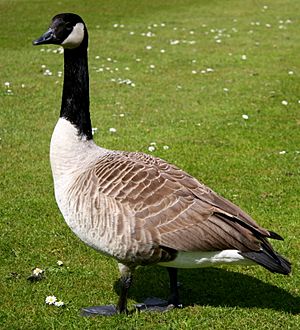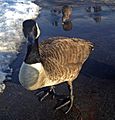Canada goose facts for kids
Quick facts for kids Canada goose |
|
|---|---|
 |
|
| Conservation status | |
| Scientific classification | |
| Kingdom: | |
| Phylum: | |
| Class: | |
| Order: | |
| Family: | |
| Subfamily: |
Anserinae
|
| Tribe: | |
| Genus: | |
| Species: |
B. canadensis
|
| Binomial name | |
| Branta canadensis |
|
 |
|
| Canada goose distribution | |
The Canada goose (Branta canadensis) is a large wild goose species with a black head and neck, white patches on the face, and a brown body. Native to arctic and temperate regions of North America, its migration occasionally reaches northern Europe. It has been introduced to the United Kingdom, New Zealand, Argentina, Chile, and the Falkland Islands. Like most geese, the Canada goose is primarily herbivorous and normally migratory; it tends to be found on or close to fresh water.
Extremely successful at living in human-altered areas, Canada geese have proven able to establish breeding colonies in urban and cultivated areas, which provide food and few natural predators, and are well known as a common park species. Their success has led to them often being considered a pest species because of their depredation of crops and issues with their noise, droppings, aggressive territorial behavior, and habit of begging for food, especially in their introduced range. Canada geese are also among the most commonly hunted waterfowl in North America.
In recent years, Canada goose populations in some areas have grown substantially, so much so that many consider them pests for their droppings, bacteria in their droppings, noise, and confrontational behavior. This problem is partially due to the removal of natural predators and an abundance of safe, man-made bodies of water near food sources, such as those found on golf courses, in public parks and beaches, and in planned communities. Due in part to the interbreeding of various migratory subspecies with the introduced nonmigratory giant subspecies, Canada geese are frequently a year-around feature of such urban environments.
Migration
Canada geese are known for their seasonal migrations. Most Canada geese have staging or resting areas where they join up with others. Their autumn migration can be seen from September to the beginning of November. The early migrants have a tendency to spend less time at rest stops and go through the migration much faster. The later birds usually spend more time at rest stops. Some geese return to the same nesting ground year after year and lay eggs with their mate, raising them in the same way each year. This is recorded from the many tagged geese which frequent the East Coast.
Canada geese fly in a distinctive V-shaped flight formation, with an altitude of 1 km (3,000 feet) for migration flight. The maximum flight ceiling of Canada geese is unknown, but they have been reported at 9 km (29,000 feet).
Images for kids
-
Canada geese grazing across the Ottawa River from Parliament Hill (2019)
-
Bathing, Oxfordshire, England
-
Flying, New Jersey
-
Male Canada goose carefully watches nearby humans in Winnipeg
-
Canada geese instinctively nest on higher ground near water. This female is nesting on a beaver lodge.
-
Family of Canada geese at Lake Arlington
See also
 In Spanish: Branta canadensis para niños
In Spanish: Branta canadensis para niños



















